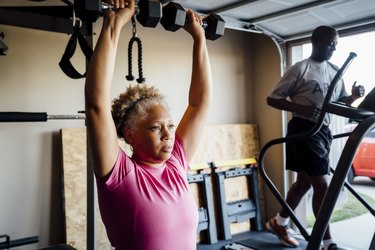
As you head into the Golden Years, the idea of lifting weights might seem silly or intimidating.
But regular strength training is linked to important health benefits for people of all ages, including increased muscle mass, stronger bones, joint flexibility, weight management and balance (experts agree that balance is particularly important for aging folks), according to the American Cancer Society.
Video of the Day
Video of the Day
In fact, the physical activity guidelines for Americans from the U.S. Department of Health and Human Services recommend that adults strength train at least twice a week.
But you don't have to be the Hulk to head to the weight room. Lifting light weights or using your own body weight (think: push-ups) can improve strength, bone density and balance, says Nancy McCarthy, an ACE-certified personal trainer, who works with older adults.
The Benefits of Strength Training for Adults Over 50
Strength training is especially important for older folks because it can help counteract the loss of muscle mass, aka sarcopenia, and decreased bone density associated with aging, explains Keri Strand, a certified personal trainer and doctoral student at the University of Miami.
"As you age, you lose a lot of muscle mass and strength, which translates to a loss of function if you don't do anything about it," Strand tells LIVESTRONG.com. "For the aging person, it's more important than anybody to try to maintain that strength and power and muscle mass for as long as possible."
You can lose as much as 3 to 5 percent of muscle mass per decade after the age of 30, according to Harvard Health Publishing. Plus, a June 2014 review in Current Opinion in Rheumatology shows that older adults tend to lose the amount of fast-twitch, or type II, muscle fibers they have.
FYI, you have two main types of muscle fibers: slow-twitch (type I) and fast-twitch muscle (type II) fibers, per the American Council on Exercise (ACE). Type I muscle fibers are activated during sustained aerobic activity, such as walking and running, as well as resistance training with light weights, but type II muscle fibers are used during more explosive, plyometric movements, such as sprints, box jumps and heavy lifts.
"Most of the danger of losing the type II muscle fibers is mass because that's what's needed for explosive movements, such as getting up out of a chair, which is a powerful move," McCarthy says.
That's why targeting your type II muscle fibers is especially important with age, and it begins with following a specific strength-training routine that works these muscle fibers so you don't lose them.
Related Reading
How to Start a Strength-Training Routine Over 50
Before you jump into a new workout plan, McCarthy says it's important to speak with your doctor to discuss any underlying conditions that might cause a problem, including high blood pressure and osteoporosis.
Whether you're new to exercise or followed a strength-training routine in your earlier years, McCarthy recommends working with a personal trainer to avoid doing too much too soon and to learn proper form, especially for older adults who might be at greater risk for injury.
A trainer, she says, can help with repositioning, adjusting the amount of resistance and providing exercise modifications. If you aren't comfortable doing a certain exercise, McCarthy says you should voice it to your trainer because it will help them gauge which modifications would work best for you. It will also inform them of how past injuries might have affected your form and mobility.
"We need to listen to our own bodies," says McCarthy, who's in her 70s. "No matter what experts are saying, if something doesn't feel right, it might not be. [Building strength] doesn't happen overnight. It takes some commitment, but it's worth it."
She says trainers will start where their clients are today — not 30 years ago. Someone who has been physically active for years, however, will progress more quickly than someone who is just starting out.
For example, an older adult who has been active might be able to walk a long distance without feeling aches or pains afterward, whereas someone who is just starting an exercise program might walk slowly for a short period of time and still be sore. "It's the same for strength training," she says.
The intensity of the workout depends on several factors, including experience, injuries and personal goals. But it's best, experts agree, to start with low weights and work your way up.
The Best Types of Strength Workouts for Adults Over 50
Generally speaking, strength training is a physical activity designed to, well, make you stronger. There are different ways to build strength, including exercises using your body weight, dumbbells, kettlebells and barbells.
Experts recommend older adults, especially if previously sedentary, start with body-weight exercises. This will help develop good form and a strong fitness base, which can help prevent injury, McCarthy says. Then, you can move to light dumbbells, resistance bands and strength-training machines.
"Almost all exercises can be done with resistance bands in place of machines," McCarthy says. "I mix up my clients' sitting and standing exercises — they think they're getting a little break when I have them sit."
The Best Strength-Training Tools for Adults Over 50
- Body-weight exercises: You use resistance from your body weight to perform exercises and build strength and muscle. Some examples are squats, push-ups and planks.
- Light dumbbells: These are traditional hand weights, which can start as light as one pound.
- Resistance bands: These are available as mini bands, long looped bands, long tubes with handles and latex elastic bands. They come in different levels of resistance, from light to heavy, and help you build muscle without putting additional pressure on your joints.
- Strength-training machines: The cable machine, lat pulldown, leg press and preacher curl are some examples of common strength-training machines you'll find at the gym. These machines allow you to adjust the weight easily and safely and engage the right muscles to practice proper form, according to the ACE. Machines aren't risk-free, but they may help control your movement pattern and range of motion, Strand says.
The Basics of Strength Training for Adults Over 50
How Many Days a Week Should You Strength Train?
In order to reap the benefits of strength training, experts recommend two to three sessions per week. Strand says it's important to break up workouts into upper body and lower body, or into push exercises, where you're pushing weights away from you, such as a chest press, and pull exercises, where you're pulling weight toward you, such as a biceps curl to avoid overtaxing your muscles.
She also says older adults should generally have two rest days between workouts. "Older individuals need longer recovery time than younger individuals," she says, noting that exactly how much time off a person needs will vary.
"There are certain exercises that can be done every day, such as core work, but if someone is experiencing soreness, I recommend at least one day, preferably two or three, before the next workout."
If you're not experiencing any soreness, you might be able to do pull exercises one day, for example, and push exercises the next. It's important to vary the type of workouts you do throughout the week, too. "I highly recommend doing cardio, yoga, relaxation and stretching on days you're not strength training," McCarthy says.
Some people, she adds, might benefit from a day without any physical activity.
How Long Should a Strength-Training Workout Be?
This varies, McCarthy says, especially for those new to the exercise. "Start with 20 minutes and then work up to longer sessions," she says, suggesting 30, 45 and 60 minutes as people build their strength.
Exercise stations are a good way to make the most of your time, McCarthy says. These stations are groups of exercises that hit major muscle groups, and you would alternate between harder exercises and easier ones.
"Multi-joint or complex exercises are a good way to maximize time, too," she says. For example, you could hold dumbbells while performing a squat and then move into a biceps curl and then into a shoulder press.
Or, she says, you can try light cardio exercise, like walking, in between strength-training sets. Older adults should also focus on the quality of their reps versus the quantity.
"Bad form is never a good thing, ever," she says. "If your muscle is failing at 6 reps instead of the planned 12, you're done with that exercise until you rest."
How Much Weight Should You Lift to Start?
Joseph Signorile, PhD, a professor in the department of kinesiology and sports sciences also from the University of Miami, recommends starting around 30 percent of the maximum weight you can lift and working up to about 75 to 85 percent. While there are many ways to determine that maximum weight, McCarthy says a good rule of thumb is if you can't complete 4 reps at a particular weight, it's too heavy. Conversely, she says, if you're going strong after 15 reps, that weight is too light.
A good way to measure intensity is to build up to a weight that allows you to complete 6 to 12 repetitions without losing proper form, she says. And she prefers that her clients move up in weight instead of adding repetitions.
"It's a great confidence booster when someone realizes they can lift 8 pounds and often do almost as many reps as they did with 5 pounds," she says.
But if the weight increase is too much — after all, equipment doesn't usually make it possible to add one pound at a time — McCarthy recommends adding reps until you're able to complete 6 to 8 reps with the heavier weight.
The 8 Best Strength Exercises for Adults Over 50
The best types of strength-training exercises and workout plans for older adults are endless, but McCarthy highlights her go-to moves for older adults below. These movements, she explains, focus on areas of the body that are crucial for improving balance and reducing the risk of falls, as well as maintaining independence.
For example, the leg press, push-up and squat require you to push forward and then return slowly, called an eccentric movement, McCarthy explains. These exercises are also crucial in helping to maintain and strengthen those type II muscle fibers.
Move 1: Squat
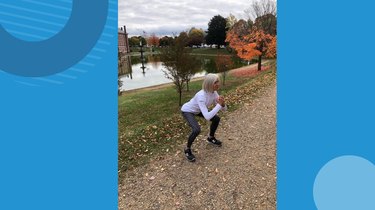
- Stand with your feet a little wider than shoulder-width apart. Keep your hands in front of you or by your hips.
- Lower your hips back and down as if you're sitting into a chair until your thighs are parallel with the ground (or as low as you can comfortably go). Your weight should be in your heels and not your toes. Make sure your knees aren't caving toward your midline.
- Push through your heels to stand back up.
Tip
If you're not able to get into a squat, try sitting down on a bench or sturdy chair on the downward phase of the squat and then push through your heels to stand back up.
Why Squats Are Important
"This is what is going to keep people out of nursing homes," McCarthy says. "Frankly, it's what's going to help them get up and down by themselves."
A squat, when done correctly, provides a lot of strength and power in the muscles needed for everyday activities, including using the bathroom and going up and down stairs.
Move 2: Elevated Plank
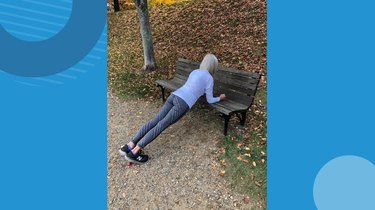
- Using a bench, box or another stable, elevated surface, rest your forearms on top with your shoulders directly stacked over your elbows.
- Step back to extend your legs out into a plank position.
- Tuck your pelvis in to engage your core and tighten your quads and glutes.
- Hold this position for 15 to 30 seconds, working your way up to two minutes.
Move 3: Side Plank

- Lie on your side and prop yourself up on your bottom forearm. Your elbow should be directly under your shoulder. Stack your top leg directly on top of the bottom one.
- Keeping your hips square, lift your hips off the ground. You should be able to draw a straight line from your heels to the top of your head. If you feel stable in this position, you can lift your top leg slightly.
- Lift your top arm straight up and hold this position for 15 to 30 seconds, then switch sides. Work your way up to holding a side plank for a full minute per side.
Tip
If you're not able to lift your hips off the ground, bend your bottom leg and keep it on the ground and straighten your top leg. Rest your free arm on your top hip as you lift your hips off the ground.
Move 4: Glute Bridge
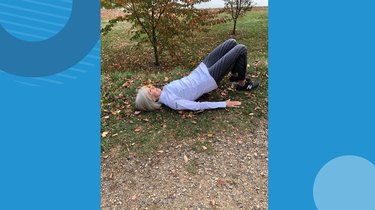
- Lie on your back with your knees bent hip-width apart and feet flat on the ground. Keep your hands by your sides and palms firmly on the ground.
- On an exhale, press your hips and lower back off the ground, squeezing your glutes at the top of the movement. Be careful not to overextend your lower back. Press your heels into the ground for more stability.
- Slowly lower your hips back down to the ground.
Move 5: Leg Press

- Sit on a leg press machine and adjust the seat so that your legs form 90-degree angles and your knees are pointing forward. Keep your feet about hip-width apart.
- Engaging your glutes, quads and hamstrings, slowly push the weight away from you, fully extending your legs out. Your calves should be parallel to the floor.
- Pause here for a second and then slowly return to the starting position.
Why Leg Presses Are Important
The leg press will strengthen hamstrings and quads, much like the squat, McCarthy says.
Move 6: Clamshell
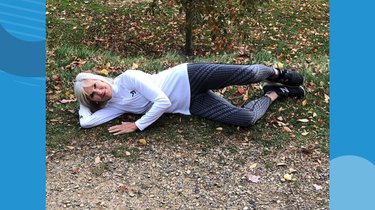
- Lie on your side with your legs stacked on top of each other, knees bent at 45-degree angles slightly in front of you.
- Rest your head on your lower arm, using your top arm to stabilize yourself. Your hips should be stacked directly on top of each other.
- Keeping your hips square and pulling your belly button in to stabilize your core, lift your top knee a few inches while keeping your feet together.
- Hold this position for a second and then slowly return your leg to the starting position. Switch sides and repeat.
Why Clamshells Are Important
McCarthy says clamshells can help strengthen the knees and hips — so many people in this population face hip and knee replacements.
Move 7: Push-Up
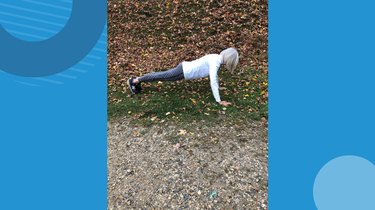
- Begin in a high plank with your core and glutes engaged. Your shoulders should be stacked over your wrists and your hips should be in line with your head and heels.
- Bend at the elbows at about a 45-degree angle from your torso and lower your body toward the ground.
- On the way down, squeeze your shoulder blades together.
- When your chest hovers just above the ground (or however far down you can go), press into the ground and push your shoulder blades apart to return to the starting position.
Why Push-Ups Are Important
The push-up can be modified in many ways to make it accessible for people of all abilities, McCarthy says. It serves as a total-body workout.
Move 8: Row
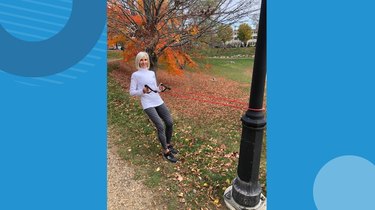
- Find a sturdy pole or fence and wrap a long, looped resistance band around it. Hold one end of the band in each hand.
- Step back until you feel some resistance and your arms are able to fully extend in front of you.
- Engaging your back muscles, pull your arms toward your rib cage, squeezing your shoulder blades together.
- Slowly release back to the starting position.
Why Rows Are Important
McCarthy says it's important to focus on push and pull exercises — those that work the front part of your body and the back. A row is a pull exercise that works the back. It's possible to do this exercise with resistance bands, weights or a cable machine.
- American Cancer Society: "5 Benefits of Strength Training"
- U.S. Department of Health and Human Services: "Physical Activity Guidelines for Americans"
- American Council on Exercise: "Seated Leg Press"
- American Council on Exercise: "5 Exercises to Add to Your Lower Back Exercise Program"
- Current Opinion in Rheumatology: "Sarcopenia in Older Adults"
- Harvard Health Publishing: "Preserve Your Muscle Mass"
- American Council on Exercise: "Muscle Fiber Types: Fast-Twitch vs. Slow-Twitch"
Was this article helpful?
150 Characters Max
0/150
Thank you for sharing!
Thank you for your feedback!